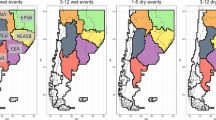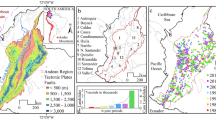Abstract
The relationship between four monthly Northern Hemisphere (NH) atmospheric circulation indices, defined as Varimax rotated principal components (VRPC) of monthly average 500 hPa surface geopotential heights for the NH, and the Danube River Basin (DRB) monthly precipitation amount anomalies for 26 weather stations and average monthly discharge anomalies for 10 hydrological stations on a major waterway of the DRB was analysed for the period 1961–2010. A weak average correlation was established between the Northern Atlantic Oscillation (NAO), the Eastern Atlantic (EA) and the Scandinavian (SCA) index and the monthly precipitation/discharge anomalies for the DRB, while a more significant average correlation was established for the Eastern Atlantic/Western Russia (EA/WR) index, especially in the winter season. A type of DRB precipitation index, based on principal component analysis (PCA), was used for the classification of DRB monthly precipitation totals and average monthly discharge anomalies into similar space patterns. A mutual relationship between these patterns and the European-Northern Atlantic sea-level composite maps was achieved. The clustering indicated the relationship between synoptic scale spatial features in sea-level pressure anomalies for the European-Northern Atlantic region and the DRB monthly precipitation and discharge anomaly spatial patterns. A statistic of typical pattern frequency of precipitation/discharge anomalies was obtained and discussed.





Similar content being viewed by others
Notes
The time average can be defined as the arithmetic mean of the whole sample of the data or for each month of the year when annual “periodic” component is removed. In the latter case, deviations are referred to as anomalies (deviations from the climatic average). If deviations are centred at time average, the S-mode will be in consideration. However, if they are centred at space average, the T-mode will be used. The S-mode is used in this paper.
References
Barnston AG, Livezey RE (1987) Classification, seasonality and persistence of low-frequency atmospheric circulation patterns. Mon Weather Rev 115:1083–1126
Bartolini E, Claps P, D’Odorico P (2009) Interannual variability of winter precipitation in the European Alps: relations with the North Atlantic Oscillation. Hydrol Earth Syst Sci 13:17–25
Belz JU, Goda L, Buzas Z, Domokos M, Engel H, Weber J (2004) Flow regime of River Danube and its catchments. International Hydrological Programme of UNESCO. Koblenz & Baja.
Bonacci O, Trninić D, Roje-Bonacci T (2008) Analysis of the water temperature regime of the Danube and its tributaries in Croatia. Hydrol Process 22:1014–1021
Bouwer LM, Vermat JE, Aerts JCJH (2006) Winter atmospheric circulation and river discharge in northwest Europe. Geophys Res Lett 33:1–4
Buzzi A (1992) Analysis and modeling of a summer case of Alpine lee cyclogenesis associated with organized convective activity. International Workshop on Mediterranean Cyclones Studies. Trieste, Italy, 18-22 May, 1992, 5-8
Christensen JH, Hewitson B, Busuioc A, Chen A, Gao X, Held I, Jones R, Kolli RK, Kwon WT, Laprise R, Magaña Rueda V, Mearns L, Menéndez CG, Räisänen J, Rinke A, Sarr A, Whetton P (2007) Regional climate projections. In: Climate change 2007: the physical science basis. Contribution of Working Group I to the Fourth Assessment Report of the Intergovernmental Panel on Climate Change [Solomon S, Qin D, Manning M, Chen Z, Marquis M, Averyt KB, Tignor M, Miller HL (eds.)]. Cambridge University Press, Cambridge and New York
Halmova D, Pekarova P, Olbrimek J, Miklanek P, Pekar J (2015) Precipitation regime and temporal changes in the Central Danubian Lowland Region. Adv Meteorol 2015:1–12
Huth R, Beck C, Philipp A, Demuzere M, Ustrnul Z, Cahynová M, Kyselý J, Tveito OE (2008) Classifications of atmospheric circulation patterns – recent advances and applications. In Trends and Directions in Climate Research. Ann.N.Y. Acad Sci 1146:105–152
Ionita M, Scholz P, Chelcea S (2015) Spatio-temporal variability of dryness/wetness in the Danube River Basin. Hydrol Process 29:4483–4497
Kingston DG, Lawler DM, McGregor GR (2006) Linkages between atmospheric circulation, climate and streamflow in the northern North Atlantic: research prospects. Prog Phys Geogr 30:143–174
Knippertz P, Ulbrich U, Marques F, Corte-Real J (2003) Decadal changes in the link between El Niño and spring-time North Atlantic Oscillation and European-North African rainfall. Int J Climatol 23:1293–1311
Pandžić K, Kisegi M (1990) Principal component analysis of a local precipitation field within the global circulation. Beitr Phys Atmos 63:101–116
Pandžić K, Trninić D (1998) The relationship between the Sava river basin annual precipitation, its discharge and the large-scale atmospheric circulation. Theor Appl Climatol 61:69–76
Pandžić K, Trninić D (2000) Relationship between monthly precipitations, the Sava river discharge and large-scale circulation. Geofizika 16-17:53–63
Preisendorfer RW (1988) Principal component analysis in meteorology and oceanography. Elsevier, Amsterdam
Prohaska S (2013) Water resources in the Danube River Basin. In: Resources of Danube Region: the Possibility of Cooperation and Utilization. Humbolldt-Club Serbien, Belgrade, pp 287–294
Rimbu N, Boroneant C, Buta C, Dima M (2002) Decadal variability of the Danube river flow in the lower basin and its relation with the North Atlantic Oscillation. Int J Cliatol 22:1169–1179
Rimbu N, Dima M, Lohman G, Stefan S (2004) Impacts of the North Atlantic Oscillation and the El Niño-Southern Oscillation on Danube river flow variability. Geophys Res Lett 31:1–4
Steirou E, Gerlitz L, Merz HAB (2017) Links between large-scale circulation patterns and streamflow in Central Europe: A review. J Hydrol 549:484–500
Vilfand RM (1977) Primenenie objektivnoi tipizaci meteorologiceskih polei k mesjacnomu prognozu anomalii temperature vozduha na ETS. Meteorol Gidrol 2:28–35
Walker DT, Bliss EW (1932) World weather V. Mem R Meteorol Soc 4:53–84
Wibig J (1999) Precipitation in Europe in relation to circulation patterns at the 500 hPa level. Int J Climatol 19:253–269
Wilks DS (2006) Statistical methods in the atmospheric sciences. Elsevier, London
Author information
Authors and Affiliations
Corresponding author
Additional information
Publisher’s note
Springer Nature remains neutral with regard to jurisdictional claims in published maps and institutional affiliations.
Rights and permissions
About this article
Cite this article
Pandžić, K., Likso, T., Trninić, D. et al. Relationships between large-scale atmospheric circulation and monthly precipitation and discharge in the Danube River Basin. Theor Appl Climatol 148, 767–777 (2022). https://doi.org/10.1007/s00704-022-03977-x
Received:
Accepted:
Published:
Issue Date:
DOI: https://doi.org/10.1007/s00704-022-03977-x




